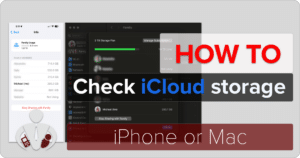While I spend a lot of time writing articles for HighTechDad during the off hours and in my spare time, my day job as Technology Evangelist for the cloud infrastructure company, GoGrid, allows me to do a lot of other types of articles. These articles tend to focus on the cloud, GoGrid product and service features, How-To’s, and reflections on the cloud industry in general. But I recently realized something, my tech-savvy audience at HighTechDad might not be aware of the other content I create on the GoGrid blog.

Over the past 5+ years, I have been writing several articles a month championing the power of cloud computing. And some of the most successful articles are ones that help people – specifically my How-To articles. So I thought, as a form of introduction, that I would include a few of my How-To’s on HighTechDad in case you are searching for answers on ways to implement the cloud within your business.
HighTechDad’s How-To Articles on the GoGrid blog
The following articles are listed in chronological order (from newest to oldest) and include a summary of the type of content you can expect to find in the article. This is just a sampling. I encourage you to read other articles on the GoGrid blog directly.
Article: How to Create a Distributed, Reliable, & Fault-Tolerant GoGrid Dynamic Load Balancer
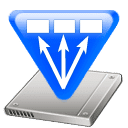
Summary: Load balancing your cloud infrastructure means that you can make it much more robust, responsive, resilient and fault-tolerant. With the recent launch of GoGrid’s Dynamic Load Balancing service, companies can easily (via the management console or API) create and manage load-balanced infrastructure. Why is this important? Well, it allows for the easy addition (or removal) of infrastructure in the form of cloud (or physical) servers into a company’s IT topology. If load increase, you add a server (or servers) into the load balanced pool and your infrastructure becomes even higher performing. When load subsides, you can remove servers from the pool and you save on cloud infrastructure costs. This article walks through the process of creating a GoGrid Dynamic Load Balancer.
Article: How to Scale your GoGrid Infrastructure
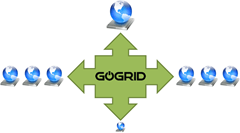
Summary: While it is easy to add servers to GoGrid infrastructure (this is called horizontal scaling), sometimes your infrastructure requires vertical scaling. Vertical scaling allows you to add more resources (like RAM or CPUs) to an existing server. For most desktops or physical servers, this is one of the best performance upgrades you can do – simply add more RAM. With a cloud server, you can accomplish the same types of performance boosts by doing the same thing. GoGrid makes it easy via just a few clicks of the mouse (or an API call). This article shows how quickly and easily vertical scaling can be done on the GoGrid cloud.
Article: How to Create a GoGrid Cloud Server Image for Rapid Scalability
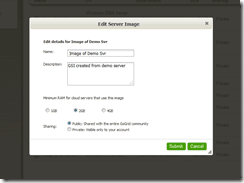
Summary: Wouldn’t it be great if you could make a copy of your personal computer or laptop, save it, and then magically create a copy of it for you to use whenever you needed it? Sure, you can do backups of your computer, but if your physical hardware dies, your backup doesn’t do much good until you get a new device. In this article, I walk through the process of creating an image of a GoGrid cloud server, saving it to cloud storage, and then creating a new cloud server based on the stored image. This is a huge plus for cloud computing – the ability to clone and instantiate new servers based on a master image.
Article: How to Select, Configure, & Deploy a GoGrid Cloud Server in Minutes
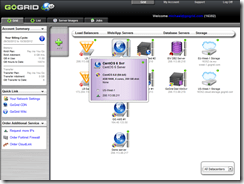
Summary: “Complex Infrastructure Made Easy” – that’s the tag line that I help develop for GoGrid. Throughout the years, we have tried to ensure that users are not overwhelmed by a complex set of tasks to create their cloud infrastructure. We kept it simple – using just a few clicks of a mouse, you can set up an entire company’s web presence from scratch. This article shows how to create the fundamental building blocks of cloud infrastructure, namely, creating a cloud server. (In fact, HighTechDad runs on GoGrid on a cloud server.)
Article: How to Install LAMP, Webmin & ConfigServer Security & Firewall on a CentOS 6.0 GoGrid Cloud Server

Summary: This was one of my more “geekier” articles and one that I had a lot of fun not only writing, but also testing out as part of the writing process. As the cloud is perfect for content providers, I wanted to craft a server that not only had the requisite LAMP stack (Linux, Apache, MySQL and PHP), but also had some added security (ConfigServer Security & Firewall) – all with an easy to use interface for many common Linux tasks (using Webmin). In fact, I had so much fun doing this How-To, I’m in the process of creating a couple more that are similar in nature. With this setup, you can easily install WordPress or Drupal, and I tried to write it in a way to allow a user who is not as familiar with Linux complete the process.
More How-To’s Coming
I absolutely love writing how-to articles. I have done plenty of How-To’s on HighTechDad and am currently working on quite a few more on the GoGrid blog. While I have some ideas for content using GoGrid, I’m always open to suggestions on content that you might find relevant or useful for your business or just for personal use. I’m happy to answer any questions about cloud computing or GoGrid (or about any type of technology for that matter). If you have a questions or need better understanding or explanation on any of these articles, please feel free to drop me a note via my Contact form or leave a comment on this article and I will do my best to respond to it.
HTD says: I love both reading and writing How-To articles! Do you!





